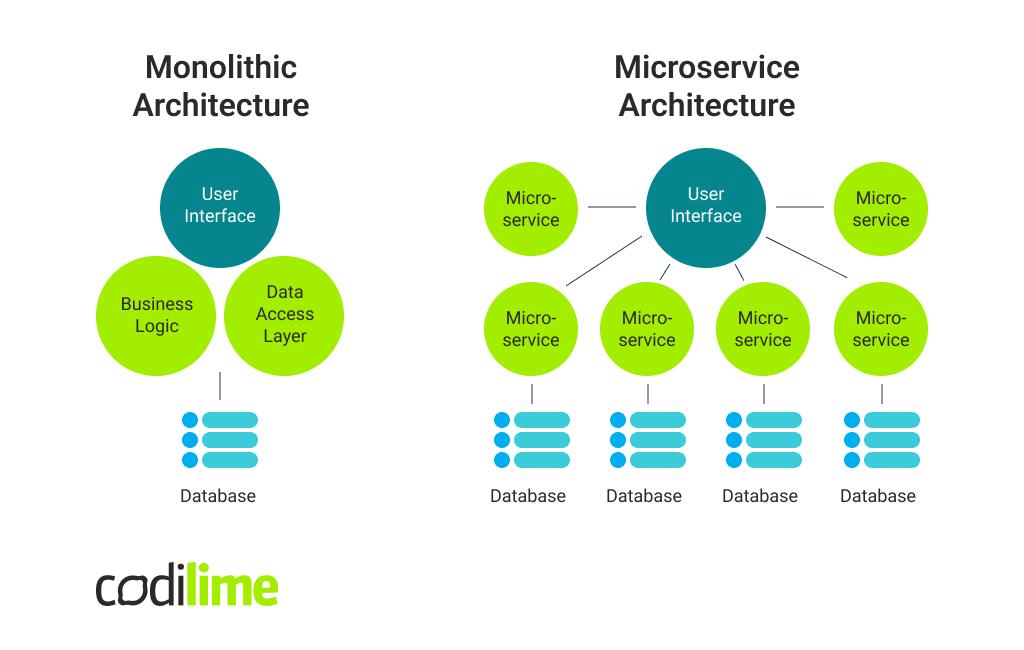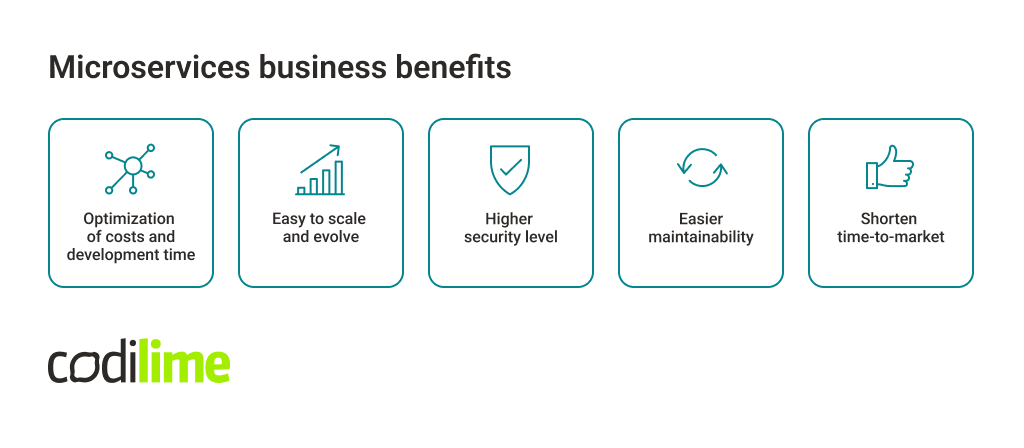According to O’Reilly1, only 8% of businesses have no success with microservices. The rest notice at least some improvements. That many satisfied customers is the best proof that microservices are worth your attention and time if you want to bring your projects to the next level.
This article will focus on how microservices can positively impact your business and how they can accelerate software development time.
What is microservices architecture?
Microservices Architecture is a mode of development that focuses on developing a system as a set of small services. This approach to software architecture relies on many functional entities being delivered as lightweight microservices instead of one heavyweight application providing all functionalities. Microservices can be developed, tested, deployed, and maintained independently.
Organizations can develop microservices-based applications in response to new business needs or opportunities without affecting the existing services' life cycles or release schedules.
The difference between microservices and monolithic architecture
To give a better insight into microservices architecture, let’s compare it to the more traditional solution – monolithic architecture.
In monolithic architecture, functionalities work through a single process, so if there is the need to implement a new feature or scale up the application, the whole architecture has to be changed in some cases. As a single unit, monolithic applications require a strictly defined program language or technology to be used. Over time, the monolithic codebase became very hard and costly to manage. The development team spends its time trying to keep the solution alive, eliminating more and more bugs instead of working on new features and product development.
On the other hand, microservices consist of many individual units – each of them handles particular functions. Thanks to this, improving functionality requires changes only in the relevant dedicated service, not the whole architecture. Last but not least, developers can use different programming languages or technology for each microservice.

Fig. 1 Monolithic architecture vs microservice architecture
When can you use microservices?
Microservices are an option for both big companies and startups. As the project evolves, microservices are more flexible and it is easier for development teams to remove or add new units according to specific needs.
For which project types can you consider microservices?
- When integration with other applications through web services is required.
- It is hard to predict how much the application will expand.
- There is no certainty as to what kind features will be necessary in the future.
- The project will be set up in a multi-cloud environment.
- The organization wants to switch to serverless architecture.
- The project requires good data isolation and security; e.g, in health care organizations.

Fig. 2 When to use microservices
The above list is not exhaustive, however it covers the most common scenarios. Do you want to check if your case is suitable for microservices? Contact our experts.
Advantages of microservices architecture
The list of microservices advantages can differ according to project requirements and business needs. The below points reflect benefits that are, as a rule, those most often appreciated by organizations.

Fig. 3 Microservices business benefits
Optimization of costs and development time
With microservices architecture onboard, the business will see savings – mainly in the long run, not immediate results.
The reduced costs of scaling, upgrading, or implementing new features or faster time-to-market of improved features or entire products are just a couple of examples of how microservices can benefit an organization.
The flexibility of this architecture can not be overlooked. As mentioned earlier, microservices are many individual units, and each of them can be managed separately.
Thanks to that, particular modules can be deputed to a dedicated team – whether in-house or remote.
Easier maintainability
Microservices, compared to monoliths, are easier to maintain. In the case of bugs or the need to implement an update, changes are only made to the relevant service. The rest of the architecture stays intact and unchanged.
Moreover, every service can be modified and deployed independently.
Higher security level
As services are separated from each other, it is easier to take care of overall system security. If any error or issue occurs in one service, it will not usually influence the work of others.
Microservices architecture allows for repairing vulnerable elements separately, which is appreciated by modern businesses that focus on providing a high level of security in their products or services.
Shorten time-to-market
Each microservice can be developed according to market needs and the company's business goals. This is an excellent advantage for an organization as it can better manage its resources and allocate them more efficiently according to priority. Only key services are developed, without the company needing to invest in the whole system at once.
Easy to scale and evolve
This advantage has already been mentioned between the lines. The opportunity to upgrade the product service-by-service and not as one extensive system allows for scaling the most crucial features without affecting the rest of the product. From a business perspective, investing in a smaller part of the system is more practical (and cost-effective) than allocating a budget for a single, colossal upgrade.
Some best practices for microservices
Below are a few tips that should be helpful when implementing microservices in the organization:
Single responsibility rule – services should not be designed as an all-in-one. In a microservices architecture, each service has only one reason to alter.
Runtime process isolation – in environments of many processes performing simultaneously, runtime must be isolated. Containerization can help you achieve this.
If you want to learn more about what a service mesh is in detail, you can check our previous publication.
Choose the technologies wisely – while choosing a technology stack for microservices, it is essential to pick the ones that align with your team's skills, organization technology stack, and service requirements.
Using DDD – domain-driven design makes it easier to design microservices to reflect the company's business goals.
More than one data storage – each microservice should have its own data storage. This helps avoid potential downtime influencing all the microservices at once.
Microservices monitoring – a monitoring system allows for better data tracking and faster alerting in case of error or bug.
This list could be much longer, however these general tips should apply to most projects.

Microservices architecture at CodiLime
Microservices are used by big names like Netflix or Spotify to provide various users with high-quality services as seamlessly as possible.
At CodiLime, we use microservices to improve the working of our clients’ applications. We have built a cloud-native microservices security platform to protect microservices effectively. At the same time, we’ve ensured that users have a clear overview of all traffic.
As a result we:
- improve the client’s application security,
- reduce errors by quicker detection of security threats and vulnerabilities, and automatically implemented security policies,
- achieve clear visualization of communication and dependencies between microservices to make the user experience better.
For more details about how we support our clients with microservices security platforms, read the whole case study.
Conclusion
Monolithic codebases become more and more expensive and harder to maintain over time due to their degradation. This inevitably leads the organization to the technical dept. Microservices can be the solution that helps spread this risk by dividing services into smaller units that are easier to maintain.
Switching to microservices architecture can be a solution for businesses that want to make products and services that are better adjusted to modern challenges, and care about regular updates to improve security and user experience.
1 O’Reilly






